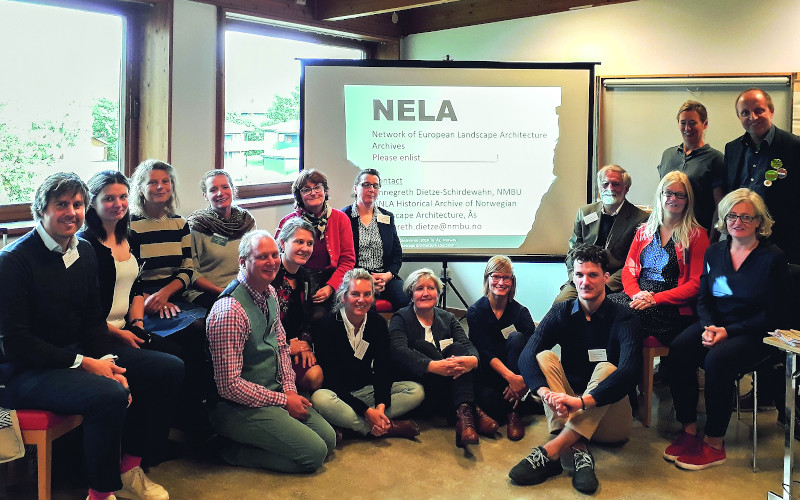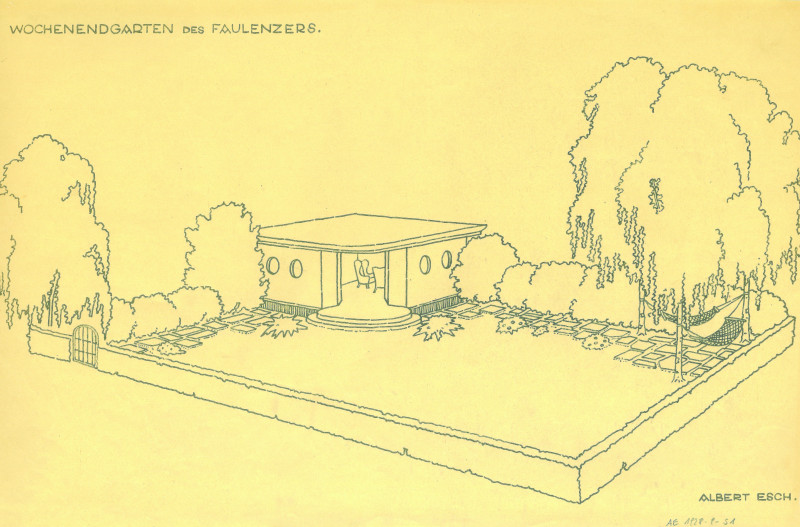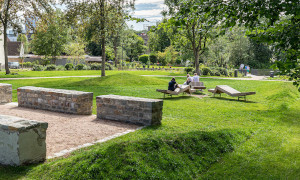September 18, 2019 will go down as a milestone in the European history of landscape architecture: In Ås near Oslo, eight European archives of landscape architecture will join forces to form the international network NELA within the framework of the ECLAS conference.
By Lilli Lička and Ulrike Krippner

The academic discipline, which is just 100 years old, thus receives the necessary historical pedestal for future challenges of research, teaching and design. The founders of the archives in Ås/Norway, in Rapperswil/Switzerland and in Vienna/Austria are the initiators of the international association.
Archives are the memory of the profession. In the landscape architecture archives of Europe, data, plans, drawings, photos, drafts, models and documents are expertly arranged, stored and made accessible to science, practice and interested laymen.
In this way, a continuity becomes visible which makes the development of landscape architecture comprehensible, and at the same time prepares the basis for its further development. The field of landscape architecture has a lot of catching up to do in this regard.
The historical narrative of the profession is particularly incomplete when it comes to more recent designs, works and personalities. The NELA network aims to close these gaps together. The exchange of content and organisation on a European level ensures continuity from the past through the present into the future, across national borders. Just as the landscape does not stop at political borderlines, styles, working methods and tasks spread across regions.
Malene Hauxner has already written about "icons on the move" (Hauxner, 2006, 53), who have been shown to spread styles across Europe. Social and natural issues are also not only local, and business has long been transnational: Competitions are tendered EU-wide, contracts are awarded internationally. The international and supra-regional exchange between archives thus promotes the development of the field on a European level, information is networked and new knowledge is generated.
Passing on knowledge, arousing curiosity
This is visible in significant publications that can be generated from archival records, most recently, for example, the publication on the gardens of the German landscape architect, reformer and pioneer of the social garden, Leberecht Migge, which were found in the Swiss archives in Rapperswil and expertly processed and are now available in a cloth-bound volume, beautifully arranged graphically (Gadient et al. 2019). 320 plans by Leberecht Migge had been hidden in the estate of the Zurich garden architect Walter Leder. Without institutions knowledgeable and willing to collect, such information will be lost forever.

The young estates of colleagues who had their main focus of work in the 20th century are often stored unnoticed by the heirs - under precarious circumstances - in garden houses or in cellars. From there, they are salvaged, added to professional archives and made available to posterity for research, information and publication.
Bringing cultural property and heritage into archives is a time-consuming and also costly task. Space, if possible with appropriate climatic conditions in terms of temperature, humidity and light, material suitable for archiving, such as acid-free folders and, above all, manpower are required for this. The knowledge of how to archive the documents, how to order them and how to manage this order requires special skills and precise expertise. The European network serves this professional exchange and mutual support in the everyday work of an archive.
NELA was founded at a meeting of the European Council of Landscape Architecture Schools (ECLAS) at the NMBU in Ås, Norway. In university education, working with and in archives has several aims: to pass on knowledge and, probably more importantly, to arouse curiosity and stimulate us to take a closer look at the foundation on which we are building. It is a longer process to understand that engagement with history goes beyond historic preservation and has a place in any project. A foundation for this understanding is knowledge of sources, awareness of historical documents and their significance, and low-threshold access to archives.
Archives are also visited and contacted by outsiders, which presupposes that their existence is generally known. When architects obtain information on the history of a historic villa for the careful renovation of its garden, the knowledge of the archives supports the preservation of historical monuments even where state provision fails. When researchers from other disciplines inquire about personalities in landscape architecture or when female role models for streets or squares are sought, as was the case in Vienna, the archives contribute to the general visibility of the discipline.
Aims of the network
Since its founding announcement, the young network NELA consists of eight members, in addition to the founding countries from Belgium, Germany, Great Britain, the Netherlands and Hungary. Founding archives are the Swiss-based ASLA Swiss Landscape Architecture (SLA), affiliated to the University of Applied Sciences Rapperswil and existing since 1982, furthermore the ANLA, officially opened in Norway in 2014, and the Austrian LArchiv, again after long preparatory work established in 2018 as an archive of the University of Natural Resources and Applied Life Sciences Vienna.
University and non-university institutions are represented and the collection periods span a wider range. For the founders, the 20th century including the late 19th and early 21st century is in the foreground, for others the documents go back several centuries.
Drawings, paintings, postcards, sketches and business correspondence, photographs, teaching materials as well as printed works are among the archived items in all archives. At the ASLA, models as well as sound documents and a large number of books are also preserved. At the ANLA in Norway and the LArchiv in Vienna, digital information is stored in databases. At the same Institute for Landscape Architecture, ILA, at BOKU in Vienna, the digital and curated database of contemporary Austrian landscape architecture, nextland, has also been maintained since 2005 - together with the ÖGLA (Austrian Society for Landscape Architecture) (Lička and Grimm 2015). This demonstrates particularly well the ambition to promote an understanding of a temporal continuum of the whole development.
The past is important for the future
Facilitating archival activities through information exchange is an important concern of the network, but it frees up capacity - it is hoped - for joint acquisition for publications and research projects at the European level. Publications and exhibitions are to be created, thus improving visibility in society and communicating landscape architecture more profoundly to the general public.
Furthermore, a supporting guideline is to be created, which represents a commitment to quality assurance. The next European meeting will be announced as widely as possible in the professional community so that others, be they teachers, researchers or practitioners, can get a picture of the landscape architecture archives of Europe.
An important concern is the careful handling of existing works, which - with or without monument protection - concern a very large part of the practical work of landscape architects. Jenny Osuldsen, landscape architect and front woman of the established office Snøhetta, emphasizes the importance of the archive work for the general professional practice: "For us practitioners, the past is just as important as the future, so that we can continue to develop and do not have to start again from scratch, there have already been so many good works that can be models for us!" (Osuldsen mdl.2019).
Literature:
Hauxner, Malene (2006): Either/or, less and more - how forms and ideas migrate. In: LAE (ed.): Fieldwork, Basel: Birkhäuser, 44-53.
Gadient ,Hansjörg; Schwerin, Sophie von and Orga, Simon (2019): Migge. The original Landscape Designs. The original garden plans. 1910-1920. birkhäuser: basel
Lička, Lilli and Grimm, Karl (2015): nextland, Collection of contemporary landscape architecture in Austria, Basel: Birkhäuser.
Authors: Dipl.-Ing. Dr. nat. techn. Ulrike Krippner and Univ. Prof. Dipl-.Ing. Lilli Lička, Institute of Landscape Architecture ILA, Department of Space, Landscape.
- Latitude: 0
- Longitude: 0


